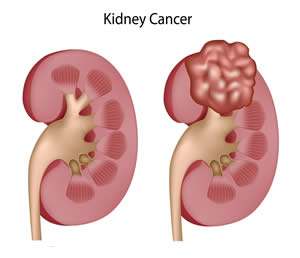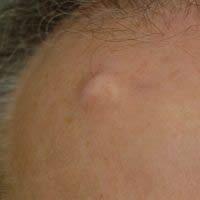Difference between Cancer and Cyst
Key Difference: Cancer, medically known as malignant neoplasm, is a medical condition in which cells divide and grow rapidly causing tumors that may cause harm to surrounding organs, or break off and travel to other parts of the body. A cyst, on the other hand, is a common skin condition that occurs among people. A cyst is a closed capsule or sac-like structure. It is typically filled with liquid, semisolid or gaseous material.
Cancer and cyst are two different types of medical conditions but can be often confused as a person may confuse a cyst as a tumor. However, cysts are different from cancer. Cancer is a disease where the lump is formed from mutated cells that constantly divide, while a cyst is a result of close sac-like structure that is filled with air, fluid or semi-solid material. Cysts are usually benign, while cancers can be dangerous. It is often confusing to tell between a cyst and a cancerous tumor for the untrained eye and a person should visit a medical professional to get a clear picture.
 Cancer, medically known as malignant neoplasm, is a medical condition in which cells divide and grow rapidly causing tumors that may cause harm to surrounding organs, or break off and travel to other parts of the body. There are three main types of tumors that may or may not develop into cancer: benign tumor, pre-malignant or malignant. A benign tumor is a small harmless tumor that is not cancerous. A pre-malignant tumor is a pre-cancerous tumor that has the possibility of developing into cancer. Lastly, a malignant tumor is highly cancerous.
Cancer, medically known as malignant neoplasm, is a medical condition in which cells divide and grow rapidly causing tumors that may cause harm to surrounding organs, or break off and travel to other parts of the body. There are three main types of tumors that may or may not develop into cancer: benign tumor, pre-malignant or malignant. A benign tumor is a small harmless tumor that is not cancerous. A pre-malignant tumor is a pre-cancerous tumor that has the possibility of developing into cancer. Lastly, a malignant tumor is highly cancerous.
Cancer happens when cells divide faster than the ability of the body to control them. The cells group themselves into small lumps of cells, which are known as tumors. These tumors can remain where they are and not grow into size, which makes them benign, while other tumors can grow in size, break off and spread to other parts of the bodies using the blood or lymph systems. Cancers when transferring to new sites often destroy healthy tissues.
Tumors are often hard to diagnose until they are grown huge in size, can be felt via touch or disrupts the process of other organs or tissues. This is mainly because there are no set signs or symptoms that are visible for each kind of cancer. There are over 200 kinds of cancers that are known to exist. Symptoms usually start occurring when tumors or cancer has grown to a certain size. There are also no definite causes of cancer, though certain substances such as radiation, environmental pollutants, lack of physical activity, obesity, tobacco use and certain infections have been known to cause mutations. Around 5-10% of cancers have even been proven to be hereditary.
Cancer is diagnosed by the presence of signs and symptoms, screening tests or medical imaging. This diagnosis is then confirmed by examining a tissue sample under a microscope. One diagnosis is confirmed, cancer can be treated using surgeries, chemotherapy and radiation therapy. Treatment must ensure that the cancerous cells are eradicated and removed to keep them from replicating again. The chances of surviving the disease vary by the type and location of the cancer, as well as the extent of disease at the start of treatment. It is estimated that in 2007, 13% of all human deaths worldwide were caused by cancer. That amounts to 7.9 million deaths.

A cyst, on the other hand, is a common skin condition that occurs among people. A cyst is a closed capsule or sac-like structure. It is typically filled with liquid, semisolid or gaseous material. A cyst is usually benign and is not harmful. However, if a cyst grows in size or is in a place where it could disrupt the function of other organs, then it could cause a problem and should be removed. If the cyst is filled with pus, the it becomes an abscess.
There are hundreds of types of cysts. They may appear just below the skin or inside the body connected to tissue or an organ. They vary in size from microscopic to the size of some team-sport balls. Large cysts can even displace internal organs. Skin cysts usually appear as an abnormal lump just below the skin and may or may not be painful. A cyst in the breasts may be noticeable when the breasts are examined by touching them and are often painful. Some cysts may not be noticeable or visible except under imaging systems. Cysts can even occur in the brain and can cause headaches, as well as other symptoms. Cysts may go away on its own or may be required to remove by a doctor.
|
|
Cancer |
Cyst |
|
Description |
Cancers are unnatural lumps, tumors or growth formed by extra cells in the body. These tumors may be solid or fluid-filled. Tumors are also called neoplasm. |
A cyst is a closed sac, having a distinct membrane and division compared to the nearby tissue. It may contain air, fluids, or semi-solid material. |
|
Occurrence |
Tumors can affect any part of the body, but usually only the cancerous tumors tend to spread to other parts of the body. |
Can occur anywhere in the body in people of any age. |
|
Types |
There are in fact over 200 different known cancers that afflict humans. |
There are more than a hundred types. |
|
Causes |
Problems with the body's immune system can lead to tumors, as well as tobacco and alcohol usage, benzene and other chemicals and toxins, environmental toxins, excessive sunlight exposure, genetic problems, obesity, radiation, viruses, among others. |
Tumors, genetic conditions, infections, a fault in an organ of a developing embryo, a defect in the cells, chronic inflammatory conditions, blockages of ducts in the body which cause a fluid build-up, a parasite, impact injury that breaks a vessel. |
|
Benign or malignant |
A tumor can be benign (not cancerous), pre-malignant (pre-cancerous), or malignant (cancerous). A malignant tumor is a tumor that is considered to be cancer. In cancer, the cells divide and grow uncontrollably. However, instead of sticking together in a singular place, as in the case of a benign tumor, these cells go all over the place and create malignant tumors in various places. Hence, cancer is not just the presence of a single malignant tumor but many. |
Most cysts are benign and are caused by plugged ducts or other natural body outlets for secretions. However, some cysts may be tumors and/or are formed inside tumors - these can be potentially malignant. |
|
Symptoms |
Symptoms vary depending on the type and location of the tumor. Some tumors may not cause any symptoms. Some common symptoms include: chills, fatigue, fever, loss of appetite, malaise, night sweats, weight loss, etc. |
Abnormal lump just below the skin and may or may not be painful. |
|
Detection |
There are ways to detect the presence of tumors. These include the presence of certain signs and symptoms, screening tests, or medical imaging, including CT or MRI scan, blood tests, etc. The type of tumor can be diagnosed by microscopic examination of a tissue sample, also known as a biopsy. |
Some may be discovered by imaging studies, such as x-ray, ultrasound, CT scan, etc. |
|
Treatments |
Treatment varies based on: the type of tumor, whether it is cancerous or not, and the location of the tumor. Some tumors may not require treatment at all, while others may be required to be removed via surgery or treated via chemo or radiotherapy. |
Cysts may go away by themselves, or must be surgically removed. Sometimes the fluid within a cyst can be drained by inserting a catheter or needle into it and collapsing it. |
Image Courtesy: staffordshireurologyclinic.co.uk, bellevue-dermatology.com









Add new comment